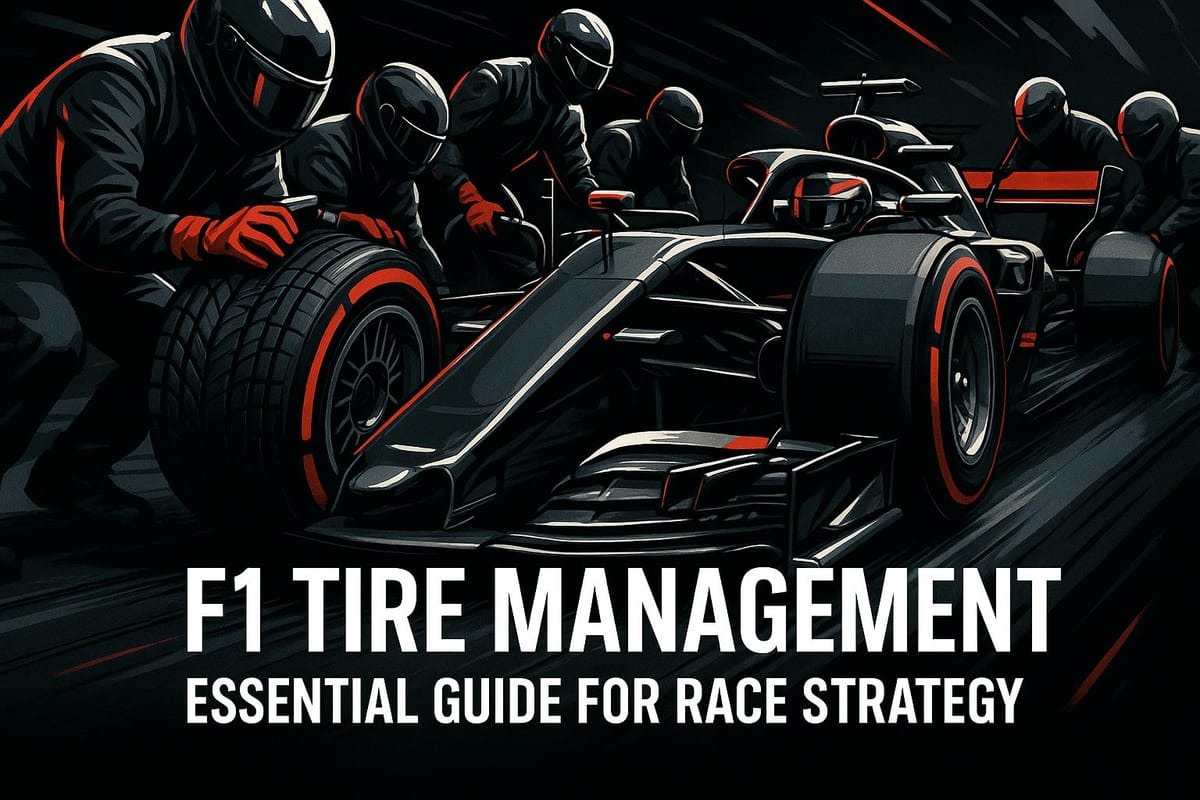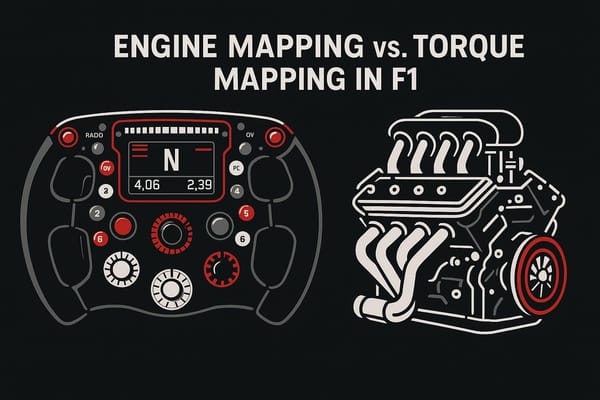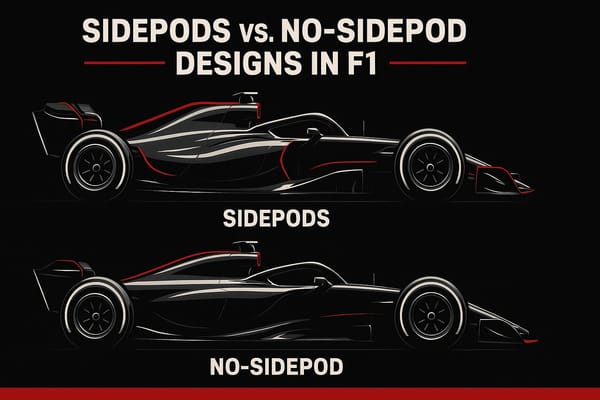F1 Tire Management: Essential Guide for Race Strategy
Explore the intricacies of tire management in Formula 1, from compounds to strategies, and discover how teams optimize performance on the track.

Tire management is the backbone of winning in Formula 1. Here's what you need to know:
- Tires are critical: They're the only part of the car touching the track, impacting grip, speed, and strategy.
- Key factors: Tire wear, temperature, track conditions, and weather drive race decisions.
- Tire types: Pirelli offers six compounds (C1-C6) for dry conditions, plus Intermediate (Green) and Wet (Blue) tires for rain.
- Strategies matter: Teams balance one-stop vs. two-stop strategies, use undercuts or overcuts, and adjust driving styles to extend tire life.
- Data-driven decisions: Real-time tire data helps teams optimize pit stops and manage degradation.
Quick tip: Mastering tire management can be the difference between winning and losing. Learn how F1 teams make every pit stop and tire choice count.
Basics of F1 Race Strategy
F1 Tire Types and Compounds
Let’s dive into the tire options available in Formula 1 and how teams use them to get the most out of their cars. Pirelli’s 2025 lineup offers a range of compounds, each designed for specific track conditions and strategies.
2025 Pirelli Tire Range

Pirelli’s 2025 F1 tires come in six compounds, from C1 (the hardest) to C6 (the softest), grouped into three main categories:
| Compound Type | Characteristics | Best Use Cases |
|---|---|---|
| Hard (White) | Long-lasting but with lower grip | Ideal for hot tracks and abrasive surfaces |
| Medium (Yellow) | A mix of durability and speed | Perfect for mid-race stints and versatility |
| Soft (Red) | Maximum grip with the fastest lap times | Best for qualifying and short stints during races |
For standard race weekends, each driver gets 13 sets of dry-weather tires: 2 Hard, 3 Medium, and 8 Soft. Sprint weekends come with a slightly different allocation: 2 Hard, 4 Medium, and 6 Soft sets. These options allow teams to tailor their strategies based on the track and race conditions.
Race Weekend Tire Selection
Pirelli chooses compounds for each race after analyzing factors like track surface, expected temperatures, lateral forces, and historical data.
"The choice is made by Pirelli, in consultation with the FIA and F1 and of course, safety is the paramount consideration, followed by the characteristics of the track and the expected temperatures, while data from previous races and simulation work also help inform the choice. Then the idea is to choose a combination of compounds that offer the greatest number of possible race strategies with the aim of delivering the best show on track." - Pirelli
During races, teams are required to use at least two different compounds, which adds an extra layer of strategy as they balance speed and durability.
Rain and Intermediate Tires
When the weather takes a turn, teams rely on specialized tires designed for wet conditions:
Cinturato Green (Intermediate)
- Made for damp or drying tracks
- Works well across varying moisture levels
- Bridges the gap between dry and wet conditions
Cinturato Blue (Wet)
- Designed for heavy rain
- Optimized for water displacement
- Reduces the risk of aquaplaning
Each driver is allocated four sets of intermediate tires and three sets of full wet tires per race weekend. This setup ensures teams can adapt quickly to changing weather, keeping performance and safety in check.
Tire Management Tactics
In Formula 1, managing tires effectively can make or break a race. Teams build on their understanding of tire selection and performance to develop strategies that maximize results during the race.
Pit Stop Strategy: 1 vs. 2 Stops
Deciding between a one-stop or two-stop strategy hinges on tire wear rates and track conditions. One-stop strategies might help maintain track position but are harder to pull off due to the high tire degradation seen in modern F1.
| Strategy Type | Pros | Cons |
|---|---|---|
| One-Stop | Saves pit stop time; keeps track position | Requires careful tire management; risk of heavy wear |
| Two-Stop | Allows flexibility with tire choice; faster laps possible | Adds pit stop time; can lead to traffic challenges |
Teams use advanced predictions to weigh the benefits of fresh tires against the time lost during pit stops, which can take up to 30 seconds each.
Pit Stop Timing: Early vs. Late
When to pit is just as important as how often. Teams typically use two key approaches:
The Undercut: This involves pitting earlier than rivals to gain an edge with fresh tires. A standout example is the 2019 Singapore Grand Prix, where Sebastian Vettel used an undercut to jump from P3 and take the lead, overtaking both Charles Leclerc and Lewis Hamilton.
The Overcut: Here, drivers stay out longer on their current tires while competitors pit, aiming to keep track position. This works best when tire wear is minimal and rivals struggle to warm up their new tires quickly.
These decisions are critical, but they’re only part of the equation. How drivers handle their tires during the race is just as crucial.
"Managing tyre degradation is the secret to executing a winning race strategy and software like RaceWatch can provide the crucial information engineers need to make quick, yet accurate decisions." - Gemma Hatton
Driving Methods for Tire Life
Drivers play a big role in extending tire life. Smooth throttle inputs, smart use of the track, and on-the-fly technical adjustments - like tweaking brake bias or using lift-and-coast techniques - can make a huge difference.
Other methods include:
- Adjusting braking points and turn-in angles
- Choosing apexes that distribute tire wear evenly
- Altering driving lines to reduce stress on tires in high-wear corners
These adjustments require constant communication between drivers and their teams, who monitor tire data in real time to fine-tune strategies during the race.
How F1 Tires Degrade
In Formula 1, managing tire degradation is a key factor in maintaining performance. Factors like wear, temperature, and pressure can quickly reduce a tire's effectiveness.
Tire Wear Factors
F1 tires are affected by several elements that determine their performance and lifespan. The main factors include wear, temperature, and pressure, each with a specific impact on degradation.
| Factor | Impact on Performance | Critical Threshold |
|---|---|---|
| Temperature | Influences compound grip | 10°F rim temp change ≈ 1°F carcass temp change |
| Surface Wear | Reduces rubber thickness | Varies by compound |
| Pressure | Affects contact patch size | Monitored via real-time sensors |
Eric Blandin, Deputy Technical Director at Aston Martin Aramco F1 Team, highlights the role of different compounds:
"Soft compounds are easier to warm up and to reach their optimum temperature, so are better suited to cool conditions and smooth tracks with less high-speed corners, where it is typically difficult to get enough energy into the tyres. Whereas hard compounds are more robust and so can generate grip at tracks with high surface temperatures and roughness, without overheating or damaging the surface of the tyre."
Wear refers to the physical loss of rubber on the tire, while degradation involves a drop in performance caused by running outside the ideal temperature range.
To handle these variables, teams rely on advanced tools and data analysis to track and manage tire performance throughout a race.
Tire Data Analysis
Formula 1 teams use cutting-edge technology to monitor tire conditions in real time. This includes:
- Tire temperature cameras for heat mapping during races.
- Pressure sensors that provide continuous updates.
- Telemetry systems to study wear patterns and predict performance.
Simone Berra, Formula 1 Chief Engineer at Pirelli, explains the importance of maintaining tire temperatures:
"The working range is the window of temperature where the tyres generate the maximum grip. If the tyres are too cold, the rubber compound can become stiff. If it is too hot, its modulus decreases and the tyres degrade. Both cases lead to lower grip."
To put this into perspective, while road car tires can last up to 40,000 miles, an F1 tire’s longest recorded stint in recent years was just 188 miles.
Engineers use specialized software like RaceWatch to interpret tire data and refine strategies on the fly, ensuring a balance between wear and performance.
Next-Gen F1 Tires
F1 tire technology is evolving, bringing new advancements that combine performance with eco-conscious design. These changes are reshaping both racing and everyday driving.
Green Tire Technology
In 2024, Pirelli introduced a full range of FSC-certified F1 tires. This certification guarantees that the natural rubber, which makes up about 15% of the tire's weight, is sourced under strict environmental and social guidelines.
Pirelli has implemented several initiatives to support its sustainability efforts:
| Initiative | Approach | Outcome |
|---|---|---|
| FSC Certification | Sourcing natural rubber responsibly | Promotes sustainable forest practices |
| Energy Usage | 100% renewable energy in production | Lowers carbon emissions |
| Design Process | Virtual prototyping methods | Reduces physical testing needs |
| Tire Warmers | Removed for full wet tires | Cuts energy usage |
| Transportation | Preference for sea freight | Minimizes transportation emissions |
"The debut of our FSC-certified tyres in the world of motorsport represents a significant moment in Pirelli's sustainability journey. In 2021 we were first to equip a road car with FSC-certified tyres, and now we are proud to be the first do so in motorsport as well. Formula 1 is an extraordinary open-air laboratory for us. It allows us not only to design and test new technology as well as improve research and development processes for roadgoing tyres, but also to unite maximum performance, typical of the demanding motorsport environment, with commitment towards an increasingly sustainable world."
These advancements are not just changing F1 strategies - they're also influencing consumer tire technology, setting new standards for performance and sustainability.
F1 to Road Car Transfer
Innovations developed for F1 are improving everyday driving experiences. The rigorous testing and development on the track lead to better tire efficiency and performance for road vehicles.
"Tire performance is highly sensitive to conditions such as temperature, surface, and driving style. Any detail is very important in our field and what we learn from Formula 1 is very useful to do better on our best performance product."
One standout example is the FSC-certified tire Pirelli created for the BMW X5 xDrive45e Plug-in-Hybrid. This tire earned an 'A' rating on the European tire label for low rolling resistance, demonstrating how F1 advancements directly benefit consumer vehicles.
The development process behind these tires is intense, involving over 10,000 hours of indoor testing and more than 5,000 hours of simulation. This extensive research improves grip, durability, and eco-friendliness, ensuring that lessons from F1 racing enhance the tires we use every day.
Conclusion: Effective Tire Management
Mastering F1 tire management requires combining technical knowledge with smart decision-making. Advanced sensors now monitor tire data in real time, helping teams make precise adjustments to driving styles and pit stop strategies based on solid data.
Here’s a breakdown of key factors that shape successful tire management:
| Factor | Impact | Strategic Consideration |
|---|---|---|
| Temperature Control | Influences grip and wear | Affects overall performance |
| Driving Style | Smooth inputs reduce wear | Balances speed and longevity |
| Track Conditions | Surface temperature shifts | Guides compound selection |
| Strategy Flexibility | Variety of compound choices | Supports dynamic race planning |
"Tyre saving is all about managing how the tyre wears and degrades, to maximise the lifetime and give the biggest options on strategy choice." – Autosport
During practice, engineers study tire degradation and tweak car setups to match. Drivers who maintain steady lap times while conserving tires often secure a critical edge, sometimes determining whether they end up on the podium or miss out on points altogether.
With advancements in tire technology and data analysis tools, teams can now manage tires with unmatched precision. Race strategy software helps predict wear patterns and fine-tune pit stop timing, ensuring every tire delivers peak performance. From selecting the right compound to timing pit stops, every decision plays a role in crafting a winning strategy. This blend of technology and planning is at the heart of F1 success.
FAQs
How do F1 teams choose the right tire compound during a race?
F1 teams select tire compounds based on several key factors, such as track conditions, weather, and their overall race strategy. Pirelli provides three dry-weather compounds for each race - ranging from the softest (C1) to the hardest (C6) - tailored to the specific demands of the track. Softer tires offer better grip but wear out faster, making them ideal for short, high-performance stints like qualifying. Harder tires last longer but provide less grip, while medium compounds strike a balance between durability and performance.
Teams analyze real-time data to decide when to pit and which compound to switch to, aiming to minimize time lost while maximizing tire performance. Strategies often involve one or two pit stops, carefully timed to maintain a competitive edge while adapting to evolving race conditions.
What’s the difference between an undercut and an overcut strategy in Formula 1?
In Formula 1, an undercut is when a driver pits earlier than a rival to take advantage of fresh tires, aiming to set faster lap times and gain position when the rival eventually pits. This strategy works best when new tires significantly boost performance.
An overcut, on the other hand, involves staying out on older tires while the competitor pits. The goal is to maintain track position and capitalize on clean air or traffic-free laps, potentially gaining an advantage if the rival struggles to warm up their new tires quickly. Both strategies depend on factors like tire wear, track conditions, and timing.
How does weather affect tire choices and race strategies in Formula 1?
Weather plays a crucial role in determining tire selection and race strategy in Formula 1. Teams must adapt quickly to changing conditions, choosing from dry-weather tires, intermediates for damp tracks, or full wet tires for heavy rain. Each type is designed to perform optimally under specific conditions, making the right choice essential for success.
Rain often introduces unpredictability, such as sudden safety car deployments, which teams can exploit to make strategic pit stops. Additionally, track and air temperatures influence tire performance - hotter conditions may lead to overheating, while colder temperatures can prevent tires from reaching their ideal operating range. Teams rely on pre-race simulations and real-time data to adjust their strategies and respond to evolving weather and track conditions during the race.




